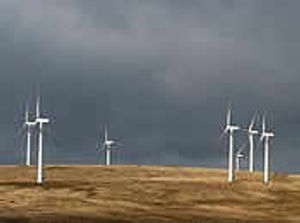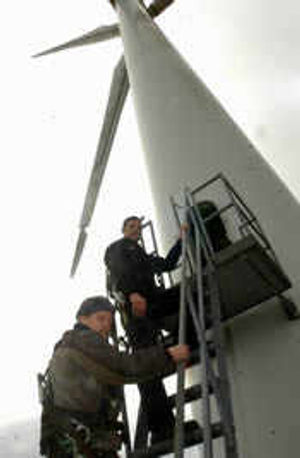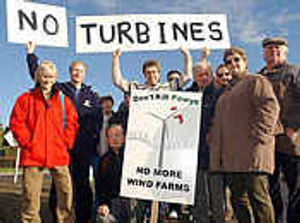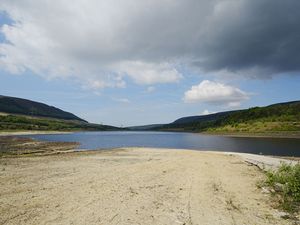Up close with a wind farm
Residents tell us they are not as noisy as portrayed and that house prices, around Carno at least, have not slumped. Neil Thomas visits a wind farm to find out how it has affected the area.

Mention wind farms and the most reasonable people can blow you down with a gale force blast of fury.
They are up there with factories, gipsy camps and telephone masts as the things people least want near their homes.
They are the hate symbols of the 21st century Nimby (not in my back yard) brigade.
Plans to put up a 60 metre mast ahead of developing a wind turbine farm near Market Drayton have unleashed a barrage of protest.
There have been almost 400 objections from campaigners and five parish and borough councils against the scheme by energy company Nuon Renewables.
Residents fear a wind farm would be an eyesore, devalue their properties and create noise. Councillors were debating the issue this afternoon.
But are these genuine concerns or just myths? How many of those objectors have visited a wind farm, stood beneath a turbine or troubled to find out whether nearby house prices slump?
Neighbouring Powys has lived with wind farms for more than a decade now. The 103 antiquated turbines on the hills of Llandinam, near Newtown, might surprise the passing stranger as they appear, suddenly and gigantically on the horizon, but to the locals they are just an accepted part of a landscape established in 1993.
When it opened in 1996, the wind farm at Carno, near Newtown, was the most powerful in Europe, the 56 turbines generating 3 megawatts as opposed to the 300 watts at Llandinam. Bigger farms have since been built in Scotland, but Carno is still pretty impressive.
I drove up to Trannon Moor yesterday to take a look for myself. On an overcast day it is downright eerie. Dark, scudding clouds. Miles and miles of undulating scrub and boggy heathland. A few bedraggled sheep but not a human soul in sight. It was like the set of a sci-fi movie . . . a chilling tale of the last man on earth, etc, etc.

Noise? Right up close - a faint whistle. In my car, 50 yards away, I didn't hear them.
Then, unexpectedly, humanity appeared in the guise of Christopher and Ann Sams, their daughter Wendy and pet sheepdog Tom. They were enjoying a walk across the network of public footpaths on the moor. They live nearby and, to them, a wind farm is a thing of beauty.
Ann says: "We love it up here. We walk here quite often. And our grandchildren think it's wonderful. They play games. They enjoy jumping in and out of the shadows of the turbines, or counting the numbers on them the way children like taking bus and train numbers.
"I think it's a beautiful place. So peaceful. We're thinking of bringing the children up for a night walk which should be quite something."
Ann, this place has a spookiness in broad daylight . . . but night!
Then more people appeared on the horizon. Service technicians Haydn Williams and Darren Bloor were carrying out maintenance work on the turbines. They were busy checking bolts, hoovering out and making sure everything was safe, spick and span.
"They are given a bi-annual service, which can take months. It's a bit like painting the Forth Bridge," said Haydn. "It means I can work where I live and it gets you out in the open. I couldn't go back to a factory job again."
"There are months of training involved but it's a worthwhile job," added Darren, who re-trained after life in the Royal Navy.
Haydn and Darren have worked at the site for 12 and two years respectively. That's another plus. Wind farms bring employment - around 100 at Carno.
The site is owned by npower and their operations supervisor for England and Wales, Mike Davies, heads a team at nearby Llanidloes.

"And what are the alternatives? Do people really want nuclear power stations all across the UK?"
As for hitting house prices, Mike says. "When I first came to work here, the nearest house, just below the hill, was worth £150,000. It recently sold for £300,000. Wind farms do not affect house prices one bit."
AT CARNO:
56 turbines - combined maximum power 33 megawatts
Tower height: 31.5 metres
Rotor diameter: 44 metres
Rotor speed: up to 30 rotations per minute
Supplies: 13,900 homes and businesses
Cost: £26 million to develop and £450,000 a year to run.
HOW IT WORKS:
Wind speed needs to be at least 11 miles per hour. Then the rotating blades drive a gear box connected to a generator.
Electricity is generated through cables running down the inside of the turbine tower, along underground cables to the sub-station. There it is connected to the local grid for distribution to homes and businesses.
The process stops when wind speeds reach 56mph or more.
GENERAL FACTS
It's not a new concept. At the end of the 18th century there were 10,000 windmills operating across the UK. By comparison, there are currently 1,769 turbines.
Wind is the fastest growing energy technology
Currently 70 per cent of electricity is provided by burning fossil fuels. Another 25 per cent comes from nuclear power. The Government is working towards a target of providing 10 per cent of electricity from renewable sources by 2010
There is a limited supply of fossil fuels and burning them emits harmful gases, leading to global warming and climate change. Wind is clean - and won't run out.
npower, which runs Carno, currently powers 100,000 homes nationally as well as businesses like Ikea, Sainsbury's and the Ministry of Defence.
Wind farms have a 20-year life span. They can be removed without trace or a legacy of pollution.
Price to the consumer isn't particuarly cheaper - people sign up because they want to make a difference in the fight to save our planet.
By Neil Thomas





